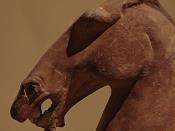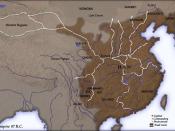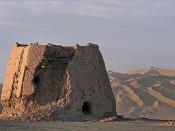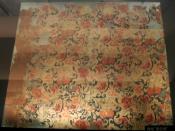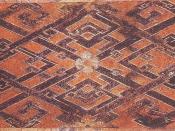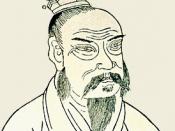Han Dynasty During the 426-year span of the Han dynasty a number of things change in China. One of the major changes that took place was the area of China. They expanded the country to almost the same size as it is today (Harvey J. Feldman). Confucianism grew to be very popular and grew to be the official state religion system. There were rapidly growing studies such as agriculture, arts, and literature; as well as the population.
There were many different rulers in the long span of the Han dynasty. Some were strong and powerful, others were weak and had failed. As the previous dynasty to the Han, the Qin dynasty began to fall, Liu Pang to head of a small army of soldiers and eventually began to conquer small territories once belonging to the Qin dynasty. His armies began to grow and more victories followed. In 206 BC, Liu named himself the king of Han, one of the states within the Qin Empire.
By 202 BC the last rulers of Qin were dead, and Liu had conquered all his rivals; he declared himself emperor and adopted the title, Gaozu. The economy had bettered, Gaozu had harsh laws were abolished, taxes were lowered. Gaozu ruled until his death in 195 BC. Following his death, his rule was passed to his heirs, the most famous of those being Wu Di who ruled from 141 BC 87 BC. Since the beginning of his reign, Wu Di was set on expanding his empire. He ran into some troubles in doing so. For quite some time, there had been a local tribe of warriors invading the northwest. Wu Di sent several missions against them. He joined with parts of Asia to finally bring down the tribe, know as Xiongnu. Now with the northwest front secured under his control, he began to expand into territories of what is now known as Korea. He later added areas south of the Yangtze River and parts in present day Vietnam. During Wu Di's rule, came the Silk Road, around 100 BC. The Silk Road was a 4000-mile long trade route, named for the silk that was transported on it, which linked Rome with the then capitol of China, Chang'an. This road allowed china to now trade with states in Europe and near the eastern Mediterranean. At the time of Wu Di's death in 87 BC, it has said to be compared in size to that of the futures Roman Empire.
Wu Di's successors tried to maintain his empire, and did for a short period of time. But then in a short span of time, three weak rulers in a row allowed an enemy to reach power, Wang Mang. The power was in the hands of a new Xin dynasty. The Xin dynasty did not last very long (9 AD-23AD). But a rebellion was formed and a civil war broke out. In 23 AD an army stormed into Chang'an and killed Wang Mang. The Han dynasty was again in control.
During the civil war, the old capital of Chang'an was badly damaged, and the Liu family moved the capital east to Luoyang. The name Han was again used, but Chinese historians refer to the dynasty after Wang Mang as the Eastern, or Later, Han. Which lasted until 220 AD.
The economy of the Han dynasty, in both east and west, was doing very well in that span of time. During the empire, the Chinese were agricultural people. Wheat and millet were grown in northern China, as they had been in the past. Rice continued to be grown wherever farmers could get enough water in order to harvest it. Iron tools were widely used, and plowing by the use of oxen was popularized in the western Han. Water was scarce for the farmers so they came up with ideas to "harvest" their own. The Chinese farmers drained their swamps, dammed streams, and built irrigation canals to have enough water to farm. Even some large water conservancies were built. During the rule of the early Han emperors, who were very peaceful and demonstrated a very strong central government, allowed the irrigations systems to expand as the population increased. More and better crops were grown. But during the falling days of the western Han, the once strong central government went to shambles and soldiers grazed all of the land. Those once irrigations systems were destroyed. Due to that the crops all died and local famine spread. As the country grew in size, it brought new relationships with other countries and people. Han merchants and traders passed through parts of central Asia and India.
A big part of the Han dynasty was its choice of religion. Confucianism was the main way of religion and thinking. The basis of Confucianism is love. According to Feldman, Confucianism can be summed up in one sentence, "Do not do to others what you do not want done to yourself." Other important Confucianism principles include righteousness, propriety, integrity, and filial piety (Feldman).
